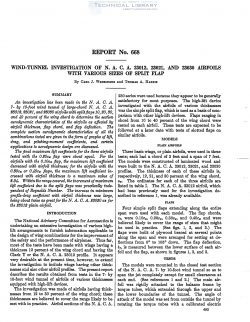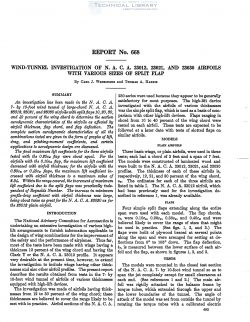naca-report-668

- Version
- 192 Downloads
- 976.04 KB File Size
- 1 File Count
- August 30, 2016 Create Date
- August 30, 2016 Last Updated
National Advisory Committee for Aeronautics, Report - Wind Tunnel Investigation of NACA 23012, 23012, 23021, and 23030 Airfoils with Various Sizes of Split Flap

The National Advisory Committee for Aeronautics is
undertaking an extensive investigation of various high-
lift arrangements to furnish information applicable to
the design of wing combinations for the improvement of
the safety and the performance of airplanes. Thus far,
most of the tests have been made with wings having a
thickness 12 percent of the wing chord and having the
Clark Y or the N. A. C. A. 23012 profile. It appears
very desirable at the present time, however, to extend
the investigation to include wings having other thick-
nesses and also other airfoil profiles. The present report
describes the results obtained from tests in the 7- by
10-foot wind tunnel of air-foils of various thicknesses
equipped with high-lift devices.
The investigation was made of airfoils having thick-
nesses from 12 to 30 percent of the wing chord; these
thicknesses are believed to cover the range likely to be
met with in practice. Airfoil sections of the N. A. C. A.
230 series were used because they appear to be generally
satisfactory for most purposes. The high-lift device
investigated with the airfoils of various thicknesses
was the simple split flap, which is used as a basis of com-
parison with other high-lift devices. Flaps ranging in
chord from 10 to 40 percent of the wing chord were
tested on each airfoil. These tests are expected to be
followed at a later date with tests of slotted flaps on
similar airfoils.
| File | Action |
|---|---|
| naca-report-668 Wind Tunnel Investigation of NACA 23012, 23012, 23021, and 23030 Airfoils with Various Sizes of Split Flap.pdf | Download |

Comment On This Post